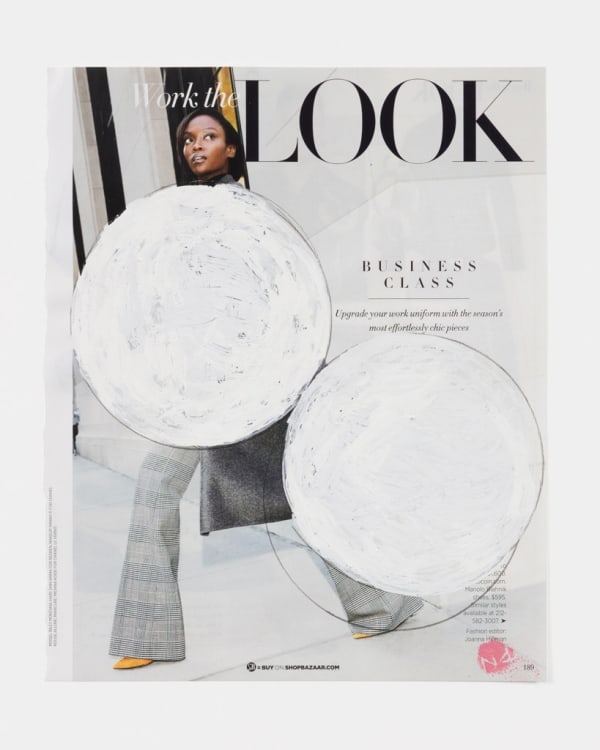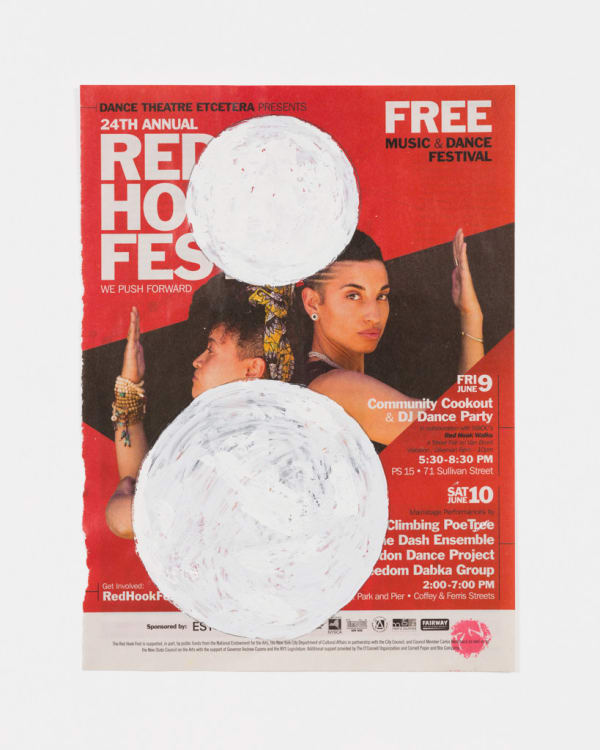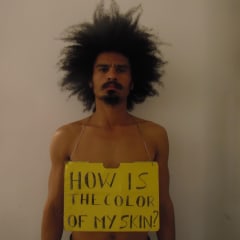INNOMINATE Paulo Nazareth
Past exhibition
Overview
Mendes Wood DM New York
September 18 – November 11, 2017
Paulo Nazareth (b. 1977, Brazil) often draws on his Afro-Brazilian and Native American heritage to investigate social constructions of race and identity. Celebrated for his complex, multi-year walk performances – his three year walk from Brazil to New York (2009/12) Noticias de America [News from the Americas] saw him trace through 19 countries collecting dust on his sandaled feet – Nazareth uses the methodology the walk to make a slow, real-time inquiry into his own experience and that of the individuals he encounters on the road. In this way, he traces a subtle, oftentimes peripheral, matrix of connections that bridge not only people but communities and shared histories. In a practice which involves the entirety of his life, Nazareth embodies the idea of the artist as a connector, a decoder, and philosopher.
INNOMINATE presents a small collection of works from Nazareth’s ongoing project Cadernos de Africa [African Notebooks] – begun in 2013 – which is organized around multiple walks throughout the Americas and the African continent. The resultant installations consist in a mixture of ephemera, drawing, and appropriation gathered and created on his journeys. Africa Notebooks began in his mother’s kitchen in a favela near Belo Horizonte, Brazil, as a way to begin to sketch the immaterial legacy of the African diaspora throughout the Americas. Tracing between these three continents, Nazareth aims to uncover overlooked connections, from foodstuffs to stories, to traditions and folklore.
INNOMINATE presents a small collection of works from Nazareth’s ongoing project Cadernos de Africa [African Notebooks] – begun in 2013 – which is organized around multiple walks throughout the Americas and the African continent. The resultant installations consist in a mixture of ephemera, drawing, and appropriation gathered and created on his journeys. Africa Notebooks began in his mother’s kitchen in a favela near Belo Horizonte, Brazil, as a way to begin to sketch the immaterial legacy of the African diaspora throughout the Americas. Tracing between these three continents, Nazareth aims to uncover overlooked connections, from foodstuffs to stories, to traditions and folklore.
Nazareth’s visual language is highly semantic and investigative, and as such, it is rich with double-entendre and metaphor. The works on view here were created in the artist’s three-month residence in New York (which was appropriately divided between the American South and the border with Mexico) and establish a series of connections between the African American experience in both South and North America. The painted white circles that wind through his drawings, aptly reference the geometric fascination of the Neo-Concrete school of art practice dominant in Brazil from the 1960’s onwards and the fact that the proponents of the movement were largely white artists from a privileged background. The contemporary reading of the white circle is directed at a social set which seeks on some level to exploit Black identity for the promotion of fashion and fashionablity. On another level, the white dots make reference to a Yoruba myth Paulo heard recounted on his travels throughout Nigeria and Benin. And at their narrative depth, the white circles are those of the painted Guinea fowl; following the British abolition of the slave trade in 1833, illegal Spanish and Portuguese slavers placed Guinea fowl on the decks above hidden slave cargo in order to conceal the noise of those below in the event of a Customs officer’s investigation.
The four sculptures placed on wooden pallets throughout the exhibition seem to represent the cumbersome weight of history, with an image of the ground itself inverted onto objects of transportation, consumption, and movement. By fracturing the continuity of the road by uprooting and appropriating ancient paving stones in various locations throughout the United States and carefully balancing them on shoes, canes, watermelons, Nazareth creates an intimate picture of oppression. Hanging above is an embroidered flannel jacket, a possible foil or solution – a specter of community and the political force of kindness in the face adversity. Given to the artist as he slept on the streets of New York on a cold spring night by a stranger, the jacket is placed as a reminder that historical violence and the marginalization of minority identity can only be undone through the subtlety of direct human contact.
The collection of videos on view help to create a fuller picture of Nazareth’s practice on the road, from West Africa to the Mexican-American border and, more recently, his work around apartheid in the Soweto township in South Africa. Nazareth lives and works throughout the world, in a constant state of transit.
Works
-
 Paulo Nazareth, NICE, 2017
Paulo Nazareth, NICE, 2017 -
 Paulo Nazareth, OLD, 2017
Paulo Nazareth, OLD, 2017 -
 Paulo Nazareth, CHINATOWN, 2017
Paulo Nazareth, CHINATOWN, 2017 -
 Paulo Nazareth, WHAT’S MY FIRT SUIT, 2017
Paulo Nazareth, WHAT’S MY FIRT SUIT, 2017 -
 Paulo Nazareth, BUSINESS CLASS, 2017
Paulo Nazareth, BUSINESS CLASS, 2017 -
 Paulo Nazareth, ENT, 2017
Paulo Nazareth, ENT, 2017 -
 Paulo Nazareth, WHITE STRIPED, 2017
Paulo Nazareth, WHITE STRIPED, 2017 -
 Paulo Nazareth, THE KOO, 2017
Paulo Nazareth, THE KOO, 2017 -
 Paulo Nazareth, FREE, 2017
Paulo Nazareth, FREE, 2017 -
 Paulo Nazareth, I DREAM A WORLD, 2017
Paulo Nazareth, I DREAM A WORLD, 2017
Installation Views












